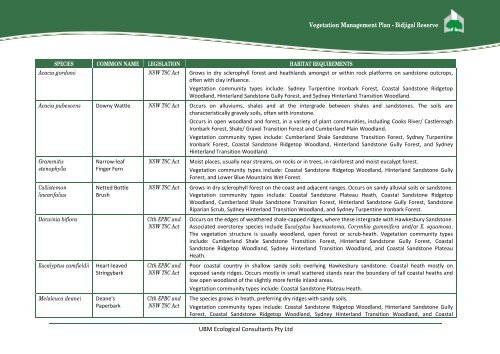VEGETATION MANAGEMENT PLAN for Bidjigal Reserve - Land
VEGETATION MANAGEMENT PLAN for Bidjigal Reserve - Land
VEGETATION MANAGEMENT PLAN for Bidjigal Reserve - Land
You also want an ePaper? Increase the reach of your titles
YUMPU automatically turns print PDFs into web optimized ePapers that Google loves.
Vegetation Management Plan - <strong>Bidjigal</strong> <strong>Reserve</strong>SPECIES COMMON NAME LEGISLATION HABITAT REQUIREMENTSAcacia gordonii NSW TSC Act Grows in dry sclerophyll <strong>for</strong>est and heathlands amongst or within rock plat<strong>for</strong>ms on sandstone outcrops,often with clay influence.Vegetation community types include: Sydney Turpentine Ironbark Forest, Coastal Sandstone RidgetopWoodland, Hinterland Sandstone Gully Forest, and Sydney Hinterland Transition Woodland.Acacia pubescens Downy Wattle NSW TSC Act Occurs on alluviums, shales and at the intergrade between shales and sandstones. The soils arecharacteristically gravely soils, often with ironstone.Occurs in open woodland and <strong>for</strong>est, in a variety of plant communities, including Cooks River/ CastlereaghIronbark Forest, Shale/ Gravel Transition Forest and Cumberland Plain Woodland.Vegetation community types include: Cumberland Shale Sandstone Transition Forest, Sydney TurpentineIronbark Forest, Coastal Sandstone Ridgetop Woodland, Hinterland Sandstone Gully Forest, and SydneyHinterland Transition Woodland.GrammitisstenophyllaNarrow-leafFinger FernNSW TSC ActMoist places, usually near streams, on rocks or in trees, in rain<strong>for</strong>est and moist eucalypt <strong>for</strong>est.Vegetation community types include: Coastal Sandstone Ridgetop Woodland, Hinterland Sandstone GullyForest, and Lower Blue Mountains Wet Forest.CallistemonlinearifoliusNetted BottleBrushNSW TSC ActGrows in dry sclerophyll <strong>for</strong>est on the coast and adjacent ranges. Occurs on sandy alluvial soils or sandstone.Vegetation community types include: Coastal Sandstone Plateau Heath, Coastal Sandstone RidgetopWoodland, Cumberland Shale Sandstone Transition Forest, Hinterland Sandstone Gully Forest, SandstoneRiparian Scrub, Sydney Hinterland Transition Woodland, and Sydney Turpentine Ironbark Forest.Occurs on the edges of weathered shale-capped ridges, where these intergrade with Hawkesbury Sandstone.Associated overstorey species include Eucalyptus haemastoma, Corymbia gummifera and/or E. squamosa.The vegetation structure is usually woodland, open <strong>for</strong>est or scrub-heath. Vegetation community typesinclude: Cumberland Shale Sandstone Transition Forest, Hinterland Sandstone Gully Forest, CoastalSandstone Ridgetop Woodland, Sydney Hinterland Transition Woodland, and Coastal Sandstone PlateauHeath.Poor coastal country in shallow sandy soils overlying Hawkesbury sandstone. Coastal heath mostly onexposed sandy ridges. Occurs mostly in small scattered stands near the boundary of tall coastal heaths andlow open woodland of the slightly more fertile inland areas.Vegetation community types include: Coastal Sandstone Plateau Heath.The species grows in heath, preferring dry ridges with sandy soils.Vegetation community types include: Coastal Sandstone Ridgetop Woodland, Hinterland Sandstone GullyForest, Coastal Sandstone Ridgetop Woodland, Sydney Hinterland Transition Woodland, and CoastalDarwinia bifloraClth EPBC andNSW TSC ActEucalyptus camfieldiiHeart-leavedStringybarkClth EPBC andNSW TSC ActMelaleuca deaneiDeane'sPaperbarkClth EPBC andNSW TSC ActUBM Ecological Consultants Pty Ltd
















